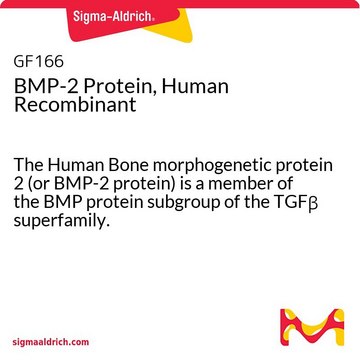B1814
BMP2, human
Carrier Free, ≥98% (SDS-PAGE), recombinant, expressed in E. coli, lyophilized powder, suitable for cell culture
Synonym(e):
BMP-2
About This Item
Empfohlene Produkte
Produktbezeichnung
Morphogenetisches Knochenprotein 2 human, Carrier Free, ≥98% (SDS-PAGE), recombinant, expressed in E. coli, lyophilized powder, suitable for cell culture
Biologische Quelle
human
Qualitätsniveau
Rekombinant
expressed in E. coli
Assay
≥98% (SDS-PAGE)
Form
lyophilized powder
Mol-Gew.
26 kDa
Verpackung
pkg of 10 μg
Lagerbedingungen
avoid repeated freeze/thaw cycles (Do not store in a frost-free freezer.)
Methode(n)
cell culture | mammalian: suitable
Verunreinigungen
Endotoxin, tested
Farbe
white
Löslichkeit
water: soluble 0.100 mL, clear, colorless
UniProt-Hinterlegungsnummer
Lagertemp.
−20°C
Angaben zum Gen
human ... BMP2(650)
Suchen Sie nach ähnlichen Produkten? Aufrufen Leitfaden zum Produktvergleich
Biochem./physiol. Wirkung
Physikalische Form
Hinweis zur Analyse
Lagerklassenschlüssel
11 - Combustible Solids
WGK
WGK 3
Flammpunkt (°F)
104.0 °F - closed cup
Flammpunkt (°C)
40.0 °C - closed cup
Hier finden Sie alle aktuellen Versionen:
Analysenzertifikate (COA)
Die passende Version wird nicht angezeigt?
Wenn Sie eine bestimmte Version benötigen, können Sie anhand der Lot- oder Chargennummer nach einem spezifischen Zertifikat suchen.
Besitzen Sie dieses Produkt bereits?
In der Dokumentenbibliothek finden Sie die Dokumentation zu den Produkten, die Sie kürzlich erworben haben.
Unser Team von Wissenschaftlern verfügt über Erfahrung in allen Forschungsbereichen einschließlich Life Science, Materialwissenschaften, chemischer Synthese, Chromatographie, Analytik und vielen mehr..
Setzen Sie sich mit dem technischen Dienst in Verbindung.



